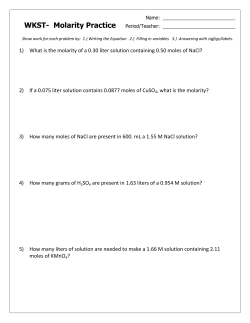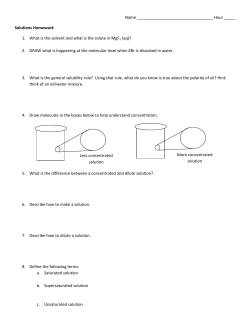
4-concentration
Concentration of Solutions Review: Solutions are made up of 1) Solute - substance dissolved or present in lesser proportion 2) Solvent - substance that is the dissolving medium - what the solute is dissolved in - many times this is water Solutions can be classified as 1) Electrolyte solutions - solutions that conduct electricity (solute is either an ionic compound or forms ions when it dissolves) 2) Nonelectrolyte solutions - solutions that do not conduct electricity (solute is a molecular compound that does not form ions as it dissolves) Components that make up mixtures can be 1) miscible - will form solutions in most any proportions (only liquids or gases) 2) immiscible substances - will not form solutions - example: oil and water There is a limit to the amount of solute that can be dissolved in a given amount of solvent this is the "solubility" of the solute. Solubility of a solute can be expressed in the following terms: 1)soluble – The substance mostly dissolves 2)insoluble – Very little of the substance dissolves 3)slightly soluble – In between: some dissolves but it may not be enough to affect the properties of the solution. Concentration • The concentration of a solution refers to the amount of solute dissolved in the solvent • Qualitative terms used are dilute (not much solute) and concentrated (alot of solute) concentrated does not mean pure. Molarity Molarity is one way to measure the concentration of a solution. Molarity (M) = moles of solute volume of solution in liters Molarity is the most used - other units include: molality, normality, formality , mole fraction, % weight, % volume (proof) Making a Solution… Sample Problem #1 3.85 g of NaCl is dissolved in enough water to make 81.0 mL of sol’n. Calculate the molarity of the solution. 3.85 g NaCl 1 mol NaCl ------------------ X ------------------- = .812M NaCl .0810 L sol’n 58.5 g NaCl Sample Problem #2 How many grams of NaCl are required to make 450 mL of .500 M soln? .500 moles NaCl 58.5 g NaCl .45 L soln X ---------------------- X ---------------- = 13 g NaCl 1 L soln 1 mole NaCl Sample Problem #3 How many mL of a .250 M NaCl soln can be prepared using 7.51 g NaCl? 1 mole NaCl 1 L soln 1000 mL 7.51 g NaCl X-------------- X ----------------X -------- = 514mL NaCl soln 58.5 g NaCl .250 mole NaCl 1 L Titration Sample Problem #4 25.0 mL of .325 molar hydrochloric acid (HCl) completely neutralizes 35.0 mL of a calcium hydroxide solution. What is the molarity of the calcium hydroxide solution? 25.0 mL 35.0 mL .325 M ?M 2 HCl + Ca(OH)2 2 H 2O + CaCl2 .0250 L HCl .325 mole HCl 1 mole Ca(OH)2 ------------------ X ---------------- X ---------------- = .116 M Ca(OH)2 .0350 L Ca(OH)2 1 L HCl 2 mole HCl Sample Problem #5 How many mL of .525 M nitric acid (HNO3) solution would completely neutralize 22.5 mL of .275 M Ca(OH)2 base solution? .525 M ? mL 2 HNO3 + .275 M 22.5 mL Ca(OH)2 ----> 2 H2O + Ca(NO3)2 .275 mole Ca(OH)2 2 mole HNO3 1 L HNO3 .0225 L Ca(OH)2 X -------------------- X ------------------- X ----------------1 L Ca(OH)2 1 mole Ca(OH)2 .525 moles HNO3 = .0236 L or 23.6 mL HNO3 Dilutions Sample Problem #6 20.0 mL of .250 M HCl solution is added to 30.0 mL of .150 M HCl solution. What is the concentration of the resulting solution? total moles total molarity = -----------------total Liters .0200 L X .250 moles/L = .00500 moles HCl .0300 L X .150 moles/L = .00450 moles HCl -----------------------------------.0500 L .00950 moles HCl total .00950 moles HCl M = -------------------------- = .190 M HCl .0500 L soln. Sample Problem #7 10.0 mL of .375 M HCl solution is diluted by adding water to a new volume of 50.0 mL of solution. What is the concentration of the resulting solution? total moles total molarity = ------------------total Liters .0100 L X .375 moles/L = .00375 moles HCl .00375 moles HCl M = ---------------------------- = .0750 M HCl .0500 L soln. Sample Problem #7 - 2 10.0 mL of .375 M HCl solution is diluted by adding water to a new volume of 50.0 mL of solution. What is the concentration of the resulting solution? M1V1 = M2V2 (.375M)(10.0mL) = M(50.0mL) M = .0750 M Sample Problem #8 Indicate the concentration of each ion present in the solution formed by mixing 44.0 mL of 0.100 M Na2SO4 and 25.0 mL of 0.150 M KCl. Na2SO4 + KCl X (No reaction!) Total Volume = 44.0mL + 25.0mL = 69.0mL=.0690L 0.100 𝑚𝑜𝑙𝑁𝑎2 𝑆𝑂4 2 𝑚𝑜𝑙 𝑁𝑎+ .0440𝐿 𝑁𝑎2 𝑆𝑂4 ∗ ∗ = 0.00880 𝑚𝑜𝑙 𝑁 𝐿 𝑁𝑎2 𝑆𝑂4 1 𝑚𝑜𝑙𝑁𝑎2 𝑆𝑂4 .00880𝑚𝑜𝑙 = 0.128 𝑀 𝑁𝑎+ .0690𝐿 0.100 𝑚𝑜𝑙𝑁𝑎2 𝑆𝑂4 1 𝑚𝑜𝑙 𝑆𝑂4 −2 .0440𝐿 𝑁𝑎2 𝑆𝑂4 ∗ ∗ = 0.00440 𝑚𝑜𝑙 𝑆𝑂 𝐿 𝑁𝑎2 𝑆𝑂4 1 𝑚𝑜𝑙𝑁𝑎2 𝑆𝑂4 .00440𝑚𝑜𝑙 = 0.0638 𝑀 𝑆𝑂4 −2 .0690𝐿 0.150 𝑚𝑜𝑙 𝐾𝐶𝑙 1 𝑚𝑜𝑙 𝐾 + .0250𝐿 𝐾𝐶𝑙 ∗ ∗ = 0.00375 𝑚𝑜𝑙 𝐾 + 𝐿 𝐾𝐶𝑙 1 𝑚𝑜𝑙 𝐾𝐶𝐿 .00375𝑚𝑜𝑙 = 0.0543 𝑀 𝐾 + .0690𝐿 0.150 𝑚𝑜𝑙 𝐾𝐶𝑙 1 𝑚𝑜𝑙 𝐶𝑙 − .0250𝐿 𝐾𝐶𝑙 ∗ ∗ = 0.00375 𝑚𝑜𝑙𝐶𝑙 − 𝐿 𝐾𝐶𝑙 1 𝑚𝑜𝑙 𝐾𝐶𝑙 .00375𝑚𝑜𝑙 = 0.0543 𝑀 𝐶𝑙 − .0690𝐿 Sample Problem #9 1.00 g of aluminum reacts with 75.0 mL of 0.300 M ZnI2 solution. How many grams of zinc are produced? 0.300 M 1.00 g 75.0 mL xg 2 Al (s) + 3 ZnI2 (aq) 2 AlI3 (aq) + 3 Zn (s) 0.300 mole ZnI2 2 mole Al 27.0 g Al .0750 L soln x ------------------ x --------------- x ----------- = 0.405 g Al 1 L soln 3 mole ZnI2 1 mole Al Al is excess or ZnI2 is limiting 0.300 mole ZnI2 3 mole Zn 65.4 g Zn .0750 L soln x ----------------- x ------------- x ------------- = 1.47 g Zn 1 L soln 3 mole ZnI2 1 mole Zn Sample Problem #10 75.0 mL of 0.300 M ZnI2 soln is added to 125 mL of 0.450 M AgNO3 soln. How many grams of the precipitate AgI are produced? 0.300 M 0.450 M 75.0 mL 125 mL xg ZnI2 (aq) + 2 AgNO3 (aq) 2 AgI (s) + Zn(NO3)2 (aq) 0.300 mole ZnI2 2 mole AgNO3 1 L soln 0.0750 L soln x --------------- x --------------- x ------------ = 0.100 L AgNO3 1 L soln 1 mole ZnI2 0.450 mole AgNO3 excess AgNO3 or ZnI2 is limiting 0.300 mole ZnI2 2 mole AgI 235 g AgI 0.0750 L soln x ----------------- x --------------- x -------------= 10.6 g AgI 1 L soln 1 mole ZnI2 1 mole AgI
© Copyright 2025









